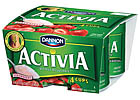
In January,USA Todayran a story that included this headline: Yogurt Cultivating Unprecedented Popularity. The ever-present national newspaper is right on target, as new products from cereal (i.e., Life® Vanilla Yogurt Crunch™) to toothpaste (i.e., Fresh Yogurt toothpaste imported from Breath Pallete™ of Japan) to pet food (Purina One®) are all being made with a touch of yogurt.
Food guru Harry Balzer with New York-based the NPD Group, describes yogurt as the food of the day and everyone is trying to leverage its popularity. "In the 20 years we've done research, only pizza has such broad appeal," he says. NPR reports that 20 years ago, 9.6% of all consumers ate yogurt at least once every two weeks. In 2005, that figure had more than doubled to 20.5%. And the way Balzer explains it, the number of yogurt consumers keeps growing.
Yogurt marketers no doubt feel this pulse, and are aggressively segmenting the yogurt category with product introductions targeting specific consumer needs. Starting with the youngest consumers, the forerunner in the baby yogurt business, Stonyfield Farm, Londonderry, N.H., recently extended its YoBaby™ Plus Fruit & Cereal cup yogurt line with two varieties (strawberry banana and raspberry pear). The yogurts are formulated with docosahexaenoic acid (DHA), an essential fatty acid associated with mental and visual development in the first years of life. A quick scan of the ingredient statement reveals that Stonyfield is using anchovy and sardine oils as its source of DHA.
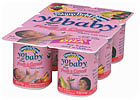
Targeting consumer segments
France-based Groupe Danone, the parent company to The Dannon Co., White Plains, N.Y., and majority owner of Stonyfield, has long been recognized for developing cultured dairy products that target specific segments of the population. In addition, the company is a pioneer in the area of probiotic dairy products. Recently, at a scientific symposium sponsored by Danone Vitapole, Groupe Danone's international research center based in Palaiseau, France, renowned experts from around the world explored the topic of probiotics and human health. The experts provided an update on research concerning the health benefits associated with probiotics such as protection, transit and nutrient absorption. Danone Vitapole also introduced a free educational DVD entitled "So, Which Bacteria Did You Eat Today?" The DVD uses animation to tell the story of two probiotic bacteria that face challenges on their journey through the human digestive tract. Dannon also offers a comprehensive probiotics online resource (www.probioticscenter.com), which is designed to bring the latest news and developments about probiotics to consumers, healthcare professionals and the media.Indeed, Dannon is pushing to educate Americans about probiotics and introduce them to probiotic dairy foods. At the beginning of this year, Dannon brought the internationally popular yogurt Activia®to the U.S. It is the first and only probiotic yogurt that is clinically proven to help naturally regulate the digestive system in two weeks, when eaten daily as part of a healthy and balanced diet, according to the company. Clinical studies indicate that Activia can help reduce transit time by up to 40%, depending on levels consumed and the demographic profile.
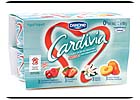
Activia was first introduced in 1987 in France and today is one of Groupe Danone's best-selling yogurt products globally, generating some 650 million Euros in 2004 sales in more than 20 countries, primarily in Europe and Asia. Globally, the brand achieved compounded annual sales growth of 24% between 2000 and 2004.
The probiotic yogurt and dairy drinks market is estimated today to be approximately $10 billion globally. Although the market in the United States is still relatively small, the functional yogurt market is growing faster than 90%, driven largely by Dannon's own DanActive™, a fermented probiotic dairy drink clinically proven to help strengthen the body's natural defenses.
"Americans are increasingly looking to food for benefits beyond basic nutrition, and probiotics, such as Activia, and our other great-tasting wellness products, including DanActive, do just this while accelerating growth in the already expanding yogurt category," says Juan Carlos Dalto, president and CEO. "As a new product, Activia is unique in how it combines great taste and a clinically demonstrated benefit."
Activia's launch is supported by a large 360-degree marketing plan, including advertising, consumer promotions and in-store sampling that began in February. Activia comes in six flavors: Blueberry, Mixed Berry, Peach, Prune, Strawberry and Vanilla. It comes in 4- and 8-packs of 4-oz cups, and sells at a suggested retail price of $2.49 and $4.49, respectively.
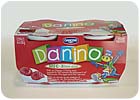
"In Canada, Danone ranks ahead of all other yogurt producers, notably because of its many high-quality innovations," says Laurent Huynh, v.p. of marketing. "It's important for us to maintain this leadership role by offering consumers yogurts that go beyond traditional nutritional functions and in doing so play a significant role in the proper functioning of the body's organisms."
With that mindset, Danone Canada is in the process of introducing Danino DHA-enhanced yogurt for children. DHA is a physiologically essential fatty acid important for normal growth and development of children. Many studies have shown that DHA plays an essential role in optimal brain and eye development and, when available in sufficient quantities, it helps improve learning, memory and concentration.
Children are a very important consumer segment for Dannon, one that can greatly benefit from probiotics, as exemplified in the company's commitment to research efforts in this area. In Washington, D.C., this past October, leading pediatricians learned that probiotics can have an effect on different gastrointestinal disorders, including diarrhea and bacterial infections and help the balance of bacteria in the digestive tract of pediatric patients.
The symposium, Probiotics and Intestinal Health in Children, led by Boston-based Harvard Medical School, Division of Nutrition, was the first program to highlight probiotics as cutting-edge science in children's health and well-being. The program was made possible by an unrestricted educational grant provided by Dannon and Japan's leading probiotic dairy company Yakult Honsha Co. Ltd.
"The concept of adding ‘good' bacteria into the diet to promote healthy digestive and immune systems is gaining recognition in the Unites States. Clinical research is quickly accumulating to support the anecdotal evidence of the benefits of probiotic therapy," says Allan Walker, professor of nutrition and pediatrics at Harvard Medical School. As investigations continue, the potential functions of these microorganisms may extend far beyond what was originally conceptualized.
Probiotics gain momentum
According to a May 2005 online global survey from New York-based ACNielsen (sample of more than 21,000 respondents, all regular Internet users, in 38 markets across Europe, Asia Pacific, North America, Latin America and South Africa), 25% of customers worldwide purchase yogurt containing probiotic cultures. In the United States, that figure is 21%, which is quite impressive for a country that did not even consider yogurt a food some 30 years ago.The top reason why consumers do not purchase such yogurts is that they do not like the taste (41% of those surveyed). Twenty percent do not believe probiotic yogurts offer additional benefits.
When it comes to fermented dairy drinks containing "good" bacteria (i.e., yogurt-based beverages), the numbers are not as impressive as those for probiotic yogurts. Globally, 16% of consumers buy such beverages. In the States, use of such fermented dairy drinks is a mere 4%, suggesting that there's a great deal of opportunity.
Indeed, the concept of probiotics is well accepted in western Europe, particularly in Germany, Finland and Sweden. Many of the products in these countries are made with a cocktail of probiotic strains that is supported by scientific documentation. In the States, probiotics are gaining momentum. They are starting to show up in more and more yogurts and fermented dairy drinks; however, ice cream, cheese and other cultured products are well poised for probiotic addition.
Recognizing this opportunity, CoolBrands International, Inc., Ronkonkoma, N.Y., reformulated its Breyers® Light brand with a specific, scientifically supported strain of Bifidobacterium. The company markets new Breyers Light! Probiotics Plus Yogurt as "complete nutrition in a cup."
New and resurrected brands
The Breyers brand was sold to CoolBrands in 2005 from Kraft Foods Inc., Northfield, Ill. Though the yogurt remained in limited distribution during the transition, it had also lost shelf space in markets where it once had a notable market share. CoolBrands has big plans for the brand, and is hoping to make a mark as a leader in the probiotics segment.A licensed yogurt brand that has been in hibernation for more than 10 years made its way back into the marketplace in January. Wells' Dairy Inc., Le Mars, Iowa, partnered with New York-based Weight Watchers International Inc., to produce Weight Watchers® refrigerated yogurts and smoothies. This is the second partnership between the two companies. Wells' Dairy also produces the Weight Watchers line of ice cream novelties.
Weight Watchers yogurt, sold in 6-oz single-serve cups, comes in nine flavors. Each serving contains only 100 calories and has only one Points® value, for Weight Watchers members who incorporate the Points Weight-Loss System into their weight-loss plan.
Weight Watchers smoothies, also made from a healthful mix of fruit and fat-free yogurt, are sold in four-packs of 7-oz bottles. Like the cup yogurts, each bottle has only one Point value.
What's the future hold for cultured dairy? It's yogurt, fermented dairy drinks and probiotics. And, of course, probiotics will likely start showing up in those cultured categories that need some reinventing.
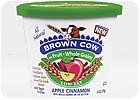
Sidebar: Functional Yogurt Boom
While many foods and beverages have entered the functional foods business, yogurt containing live and active cultures is likely in the best position to become the golden functional foods product. It comes refrigerated or frozen, and spoonable, squeezable or drinkable. Here's a quick overview of some noteworthy refrigerated yogurt introductions in the past few months-both here and abroad.Yogurt and whole grains are the perfect mix for today's health-minded consumers, as the USDA now recommends whole grains for at least half of our daily grain needs. To meet consumers' needs, Brown Cow Farm, Antioch, Calif., a part of Londonderry, N.H.-based Stonyfield Farm, introduces this month the first U.S. yogurt to include whole grains.
New Brown Cow® Low Fat Yogurt with Fruit & Whole Grains combines low-fat yogurt, real fruit, whole grains, sunflower and flax seed to provide consumers a fresh-from-the-farm taste. Made with milk from farmers who pledge not to use artificial growth hormones, the new yogurt comes in four flavors: Apple Cinnamon, Blueberry, Raspberry Pear and Summer Fruits.

In February, CoolBrands International Inc., the proud new owners of the Breyers® brand of refrigerated cultured dairy products, introduced Breyers Light! Probiotics Plus Yogurt. The new recipe for the brand's popular light yogurt features enhanced probiotic cultures. CoolBrands further boosted the yogurt's health benefits through the addition of vitamins A and D and calcium.
Breyers Light! Probiotics Plus is offered in flavors inspired by indulgent desserts such as Black Cherry Jubilee, Lemon Chiffon, Key Lime Pie and Strawberry Cheesecake. However, the yogurts contain 70% less sugar than leading low-fat sweetened yogurts and have only 110 calories or less per serving. Speaking of servings, CoolBrands offers its yogurts in 8-oz cups, which is 33% more yogurt per serving than many other leading brands that have downsized to a 6-oz cup.
"Consumers' demand for healthy yogurt goes beyond just vitamins and nutritious ingredients. It also includes other health benefits like aiding in digestion," says Matt Smith, v.p. of marketing for CoolBrands.

All of the products sporting the Benecol logo contain plant stanol esters, which have been clinically proven to reduce low-density lipoproteins (LDL), or bad cholesterol. The company cites research showing that when one cup of One-A-Day Yogurt is consumed daily (as suggested by the product's name), cholesterol can be lowered by up to 14% in as little as two to three weeks.
The company also markets Benecol Yogurt Drinks in Original, Strawberry and Light varieties. More than 100 million "little" bottles of Benecol Yogurt Drink have been sold across Europe in the past two years since the product's launch.

Numerous scientific studies demonstrate that people of all ages, from infants to adults, may benefit from an adequate supply of DHA in the diet. Yet, despite its importance, natural food sources of DHA are limited primarily to fatty fish, making it difficult for many people to get enough DHA in their diets. Priégola is using an all-natural vegetarian source of docosahexaenoic acid (DHA), the key omega-3 fatty acid for brain development and function, according to the company.
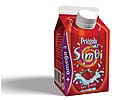
Made from algae under tightly controlled manufacturing conditions, this DHA ingredient is free of oceanic contaminants that may be present in certain fish or fish oils. Algae are the only vegetarian source of DHA, a long chain omega-3 fatty acid. Other vegetarian sources of omega-3s, such as flax seed, walnuts and certain vegetable oils, are sources of alpha linolenic acid (ALA), a shorter chain omega-3 that does not directly support brain development or function.
Indeed, using yogurt as a carrier for additional functional ingredients is the trend today, and will continue in the future.
Sidebar: Behind the Scenes in Cottage Cheese
Very little apparent innovation has taken place in the past few years in the cultured dairy category of cottage cheese. However, there has been some activity at the manufacturing level.A new technology that changes the way cottage cheese is made is putting a nearly 90-year-old dairy cooperative on the leading edge of cheese manufacturing and paving the way for a traditional dairy food to assume an up-to-the-minute identity, thanks to research sponsored by Dairy Management Inc.™ (DMI) and funded by America's dairy farmers.
Cabot Creamery, Montpelier, Vt., collaborated with CPS Scherping, Winsted, Minn., to prototype a new cottage cheese-making technology using Scherping's Horizontal Cottage Cheese Vat (HCCV). The HCCV replaces traditional open-vat cheesemaking with an enclosed system that automates every step of the process. Lloyd Metzger, assistant professor in the Department of Food Science and Nutrition at the University of Minnesota, helped develop and test the closed-vat system in a pilot program sponsored by DMI.
"Creating a product that's perfectly consistent from batch to batch is one of the biggest challenges in making cottage cheese," says Metzger. "The traditional open-vat process for cottage cheese manufacturing relies heavily on human operators, which can introduce variability. With this system, manufacturers can better control the quality of the cheese."
By automating the entire process within an enclosed system, the HCCV technology minimizes operator intervention, fluctuations in temperature and exposures to the surrounding atmosphere. The result is an extremely consistent and high-quality product. The HCCV also automates the cleaning process between batches.
Cabot now uses HCCV machines to make its cottage cheese. "This was a whole new concept for us," says Marcel Gravel, plant manager. "I think Cabot has always made an exceptional product, but installing the new system has definitely improved quality."
George Schwinghammer, sales manager at Scherping, adds, "The conventional wisdom among cheesemakers in this country has been that you can't produce cottage cheese with the proper curd size and distribution in an enclosed vat. We're overcoming that perception with a technology that also allows greater capacity."
For more information, contact the DMI Dairy Technical Support Hotline at 800/248-8829 or visit www.innovatewithdairy.com.
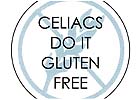
Beware of Hidden Gluten Sources
There's a growing trend towards formulating foods that are free of gluten-the protein found in all forms of wheat (including durum, semolina and spelt), rye, oats, barley and related grain hybrids such as triticale and kamut. Often when food scientists think of avoiding gluten in a product formulation, they think wheat flour only. However, there are many hidden sources of gluten in the food ingredients business, and even the slightest amount in a food product can cause the consumer many discomforts if they are afflicted with celiac disease.Celiac disease is a lifelong autoimmune intestinal disorder, found in individuals who are genetically susceptible. Damage to the mucosal surface of the small intestine is caused by an immunologically toxic reaction to the ingestion of gluten and interferes with the absorption of nutrients, and in some cases, water and bile salts. If left untreated, damage to the small bowel can be chronic and life threatening, causing an increased risk of associated disorders-both nutritional and immune related.
Celiacs know to avoid traditional sources of gluten such as bread, pasta, cookies, etc. The problem lies in the fact that gluten is hidden in many unsuspecting foods. For example, viscous dairy foods such as cultured dairy products made with any type of starch-based stabilizer cannot be consumed by a celiac. Thus, it is helpful to label the source of a starch ingredient, i.e., modified corn starch instead of simply modified starch. Some flavorings must also be avoided because they are fermented in the presence of wheat. Acidulants such as vinegar, if properly distilled, should not contain any harmful gluten, but most celiacs are not willing to take the chance unless the product is labeled gluten-free.
The cause of celiac disease is unknown, and it has become increasingly prevalent in the United States. It can appear at any time in a person's life. Statistics suggest that more than two million Americans are afflicted with celiac disease. This number may be a gross underestimation, as it is hard to diagnose and there are likely many undiagnosed cases. It is estimated that the number of sufferers of celiac disease will increase worldwide by a factor of 10 during the next few years.
The only treatment for celiac disease is the lifelong adherence to a gluten-free diet. When gluten is removed from the diet, the small intestine will start to heal and overall health improves.